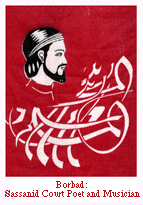
|
Iraj Gulsurkhi translated by
copyright 1995 |

|
Iraj Gulsurkhi translated by
copyright 1995 |
Firdowsi enumerates many musical compositions in his Shahname among which surud, bazh, and taranah can be mentioned. This kind of music predates the Shahname by some seven centuries. Surud is a type of music that does not have any religious connotations. It included, with certain variations, the music of the court, military music, music played at lower courts, and at the houses of nobility. The music played at court was referred to as khusravani. This khusravani, of course, was different from the type of music recognized by the same name, i.e., the music that still exists in the Humayun maqam and other maqams and the native form of which is found among the present-day Lurs, Kurds, and Azerbaijanis. Fortunately, the original form of this music is rendered in notes and can be reproduced. In recent times, however, surud has assumed an exclusively military use in marches. A number of khusravanis have survived from the time of Borbad and there may have been khusravanis by others, given the fact that Borbad composed his works exclusively for Khusrau Parviz. There are still singers in Luristan and Kurdistan who perform khusravanis. The themes of these compositions are centered exclusively on the lives of the kings. Recently, I recorded a khusravani called Khusrau and Shirin in Luristan. It is in the Luri dialect. And I should add that folk Shahname, i.e., the Shahname that has passed from generation to generation orally, is several times longer than Firdowsi's original. Thus, the composition of khusravani continues. There is even a khusravani about Karim Khan of the Zand Dynasty. The recitations are accompanied by kamancheh, often with nai-i duziyaneh or dunai, or with the tambourine. Khusravanis abound in Azerbaijan, Aran, Armenia, and Georgia. Shah Isma'il, Kurughli, and others have khusravanis of their own.1 Bazh is used in the context of worship and as such is a kind of religious zamzamkhani. It encompasses the recitation of all the hymns of Zoroaster. Indeed the hymns began with zamzamkhani and, with audience participation, reached their climax. Examples of Yasna 47, prepared for chorus and a wonderful bazh copied from the Alvand stele of the time of Xerxes, are available. Taranah belongs to the public at large. In Persian "tar" means "wet," but in this case it means "fresh." Taranah, therefore, is a musical piece that is constantly renewed. The word "reng" in Persian is a corruption of tarangeh or taranah. A different type of taranah is employed at the end of each maqam performance.
Lands in Which Persian Music Thrives The Persian language, especially in its Dari form, brings a large body of people together. But this gathering is in no way comparable to the one that is brought together by Persian music. By Persian music, of course, we mean the shur, mahur, nahavand, dugah, chahargah, and the recitation of the Shahname with its special heroic rhythm. Persian music is recognized in Armenia, Turkey, Uzbekistan, Iraq, Syria, Lebanon, Saudi Arabia, Egypt, Libya, Tunisia, Algeria, Morocco, Spain, Southern Europe, Bulgaria, Rumania, even in Austria. It has influenced the works of Ludwig van Beethoven, Wolfgang Mozart, Johannes Brahms, Dukhnani, Franz Liszt, Gadail, Bela Bartok, and Arkal. George Ansko uses Iranian melodies of the Humayun and Chakavak type in his First Rhapsody. The history of the influence of Persian music in Africa is outside the purview of this study. In this regard, suffice it to say that the Iranian musician, Zaryab, who was at the Abbasid court at Baghdad, traveled to Spain and, while there, set up a school of music and taught the fundamentals of Persian music. Zaryab's compositions are well-known in Spain. They were prepared for the guitar in 1993.
The Predecessors In spite of the manipulation of the information on the role of Persian music on the music of the Abbasid court, it is evident that Persian music and the Pahlavi language have had their impact. Abu al-Faraj Isfahani, quoting Ali Ibn-i Yahya Munajjim on the fifth tar of barbat states the following, "A long discussion occurred between Ishaq, the son of Musa Musili and Ishaq, the son of Ibrahim Mus'ab. Musili asked, 'Did you hear what he asked me? He could not figure out a simple thing like that by himself. He must have learned this from the books of the predecessors. I am sure that they have translators and that such things are being translated for them. If you happen to come across such books, keep me in mind'." The foregoing shows that during the reign of the early Abbasid Caliphs, thanks to Iranian wazirs and amirs, books on music were translated into Arabic. Even al-Farabi, documenting his sources, refers to them as the "predecessors." Neither Ibrahim, nor his son Ishaq Musili, has divulged the secret of their trade. Their secrecy and the secrecy of the other professionals at the courts of the Abbasids create a mushroom of the Arabic culture of that time-it has an attractive facade but lacks substance of its own. And even that would not have been possible without marginalizing the efforts of the custodians of the previous culture and without generalizing their contributions under the term "predecessors." The Caliph al-Mansur's astronomer who preserved the Zoroastrian tenets and whose family is well-known and trustworthy had a grandson called Yahya (d. 932). In his work called al-Nagham, in several places, Yahya refers to "the assertions of the ancients on music," but he never explains who those ancients are.2 On page three, he states that Ibrahim Musili and his colleagues devised Arabic names for musical concepts. Could the Iraqi School exist without the support of the translations of the works of Sassanian artists? Even today, many of the untranslatable Iranian concepts are evident in music employed anywhere from Dushanbe to Spain.
Selected Bibliography
From the Hymns of Zarathustra to the Songs of Borbad